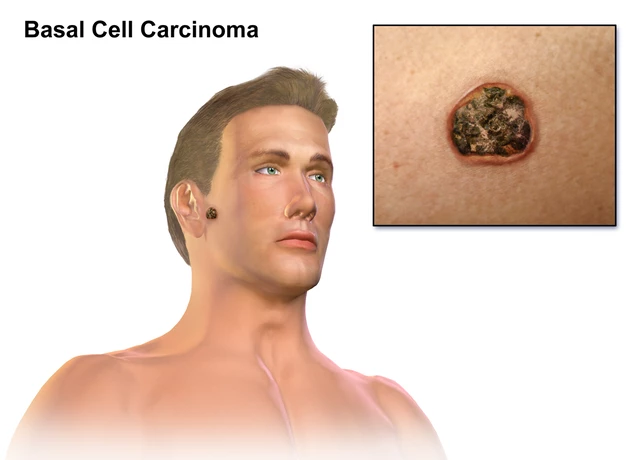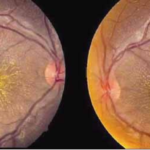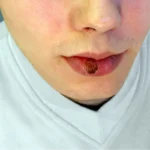Basal cell carcinoma (BCC) is the most prevalent type of skin cancer, accounting for a significant proportion of skin cancer cases globally. This article provides an in-depth examination of basal cell carcinoma, detailing its characteristics, symptoms, causes, risk factors, diagnostic methods, treatment options, and prevention strategies.

Understanding Basal Cell Carcinoma (BCC)
Basal cell carcinoma arises from the basal cells, which are found in the lower part of the epidermis, the outer layer of the skin. These cells are responsible for producing new skin cells. In basal cell carcinoma, abnormal growth and division of these cells occur, leading to the formation of cancerous lesions on the skin.
Unlike more aggressive skin cancers, basal cell carcinoma grows slowly and rarely spreads to other parts of the body. However, if left untreated, BCC can lead to significant local tissue damage and disfigurement.
Key Symptoms of Basal Cell Carcinoma
The appearance of basal cell carcinoma can vary depending on the location and type of lesion. Some common signs and symptoms include:
- Pearly or waxy bump: BCC often appears as a translucent or pearly bump on the skin, typically on areas exposed to the sun, such as the face, ears, and neck.
- Bleeding or crusting: Lesions may develop a crust or bleed, especially when scratched or irritated.
- Flat, scaly patch: Some BCCs may present as flat, flesh-colored or brown patches that resemble a scar.
- Sore that doesn’t heal: A BCC lesion may persist for weeks or months without healing, often forming an ulcer that does not improve over time.
Causes and Risk Factors of Basal Cell Carcinoma
Basal cell carcinoma primarily results from long-term exposure to ultraviolet (UV) radiation, which damages the DNA in skin cells. Several risk factors contribute to the development of BCC, including:
- UV radiation exposure: Both natural sunlight and artificial sources like tanning beds contribute to skin damage and increase the risk of BCC.
- Fair skin: Individuals with lighter skin are more susceptible to UV damage and are at a higher risk of developing skin cancer.
- Age: Basal cell carcinoma is more common in older adults, although it can occur in younger individuals as well.
- Family history: A family history of BCC or other types of skin cancer increases the likelihood of developing the condition.
- Immunosuppression: People with weakened immune systems, such as those undergoing organ transplant treatment or HIV-positive individuals, are more prone to developing BCC.
- History of sunburns: Frequent sunburns during childhood or early adulthood can increase the risk of developing skin cancer later in life.
Diagnosing Basal Cell Carcinoma
The diagnosis of basal cell carcinoma typically involves a physical examination of the skin and a biopsy. During a biopsy, a small sample of the lesion is removed and examined under a microscope to confirm the presence of cancerous cells. Additional imaging tests may be conducted if the cancer appears to have spread.
Dermatoscopic examination, a non-invasive technique using a special magnifying device, may also be used to assess the characteristics of suspicious lesions, aiding in early detection.
Treatment Options for Basal Cell Carcinoma
Treatment for basal cell carcinoma varies depending on the size, location, and type of lesion, as well as the patient’s overall health. Common treatment methods include:
1. Surgical Excision
Surgical excision is the most common treatment for BCC. During this procedure, the lesion is cut out along with a margin of healthy skin to ensure all cancerous cells are removed. This method is particularly effective for tumors located on easily accessible areas.
2. Mohs Micrographic Surgery
Mohs surgery is a specialized technique where thin layers of skin are removed and examined under a microscope until no cancer cells remain. This method is especially beneficial for BCCs located in sensitive areas, such as the face or near the eyes, as it preserves as much healthy tissue as possible.
3. Cryotherapy
Cryotherapy involves freezing the cancerous tissue using liquid nitrogen. This treatment is generally used for smaller BCC lesions and is particularly effective for superficial basal cell carcinomas.
4. Topical Treatments
For superficial BCC, topical treatments such as imiquimod or fluorouracil (5-FU) may be prescribed. These treatments involve applying a cream or ointment to the affected area to destroy cancer cells.
5. Radiation Therapy
Radiation therapy may be used for patients who cannot undergo surgery due to the location of the BCC or other health concerns. High-energy rays are used to target and destroy cancer cells.
6. Laser Therapy
Laser therapy uses focused light to remove or shrink basal cell carcinoma tumors, providing a less invasive treatment option for certain cases.
Prevention of Basal Cell Carcinoma
While it may not be possible to prevent basal cell carcinoma entirely, certain preventive measures can reduce the risk of developing BCC:
- Sun protection: Using sunscreen with broad-spectrum protection, wearing protective clothing, and seeking shade can significantly lower the risk of UV damage.
- Avoiding tanning beds: Artificial UV exposure from tanning beds is a known risk factor for skin cancer.
- Regular skin checks: Early detection of suspicious lesions can improve outcomes. Individuals should regularly check their skin for new or changing growths and consult a dermatologist if any changes are noted.
- Seeking medical advice for high-risk individuals: Those with a family history of skin cancer or who have had previous BCCs should seek regular dermatological screenings.
Prognosis of Basal Cell Carcinoma
The prognosis for basal cell carcinoma is generally excellent, as BCC rarely spreads to other parts of the body. When diagnosed early and treated appropriately, the survival rate for BCC is near 100%. However, untreated BCC can lead to significant local tissue destruction, including damage to vital structures such as nerves and cartilage.

